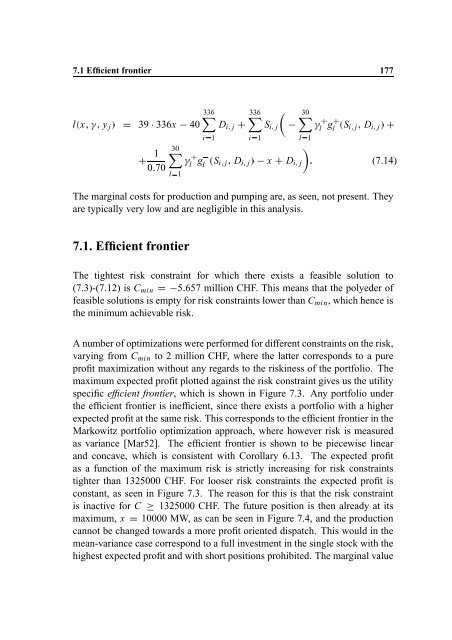Hedging Strategy and Electricity Contract Engineering - IFOR
Hedging Strategy and Electricity Contract Engineering - IFOR
Hedging Strategy and Electricity Contract Engineering - IFOR
Create successful ePaper yourself
Turn your PDF publications into a flip-book with our unique Google optimized e-Paper software.
7.1 Efficient frontier 177<br />
lG x 6 9 6 y jH 39 336x 40<br />
336<br />
1 iF<br />
l<br />
G S i5 j6 D i5 jH x D i5 j<br />
8<br />
g7<br />
D i5 j<br />
336<br />
iF 1<br />
S i5 j<br />
30<br />
lF 1<br />
4<br />
l<br />
9<br />
1<br />
0<br />
8<br />
70<br />
30<br />
lF 1<br />
4<br />
l<br />
9<br />
g4l<br />
G S i5 j6 D i5 jH<br />
(7.14)<br />
The marginal costs for production <strong>and</strong> pumping are, as seen, not present. They<br />
are typically very low <strong>and</strong> are negligible in this analysis.<br />
7.1. Efficient frontier<br />
The tightest risk constraint for which there exists a feasible solution to<br />
(7.3)-(7.12) is C min 5<br />
8<br />
657 million CHF. This means that the polyeder of<br />
feasible solutions is empty for risk constraints lower than C min , which hence is<br />
the minimum achievable risk.<br />
A number of optimizations were performed for different constraints on the risk,<br />
varying from C min to 2 million CHF, where the latter corresponds to a pure<br />
profit maximization without any regards to the riskiness of the portfolio. The<br />
maximum expected profit plotted against the risk constraint gives us the utility<br />
specific efficient frontier, which is shown in Figure 7.3. Any portfolio under<br />
the efficient frontier is inefficient, since there exists a portfolio with a higher<br />
expected profit at the same risk. This corresponds to the efficient frontier in the<br />
Markowitz portfolio optimization approach, where however risk is measured<br />
as variance [Mar52]. The efficient frontier is shown to be piecewise linear<br />
<strong>and</strong> concave, which is consistent with Corollary 6.13. The expected profit<br />
as a function of the maximum risk is strictly increasing for risk constraints<br />
tighter than 1325000 CHF. For looser risk constraints the expected profit is<br />
constant, as seen in Figure 7.3. The reason for this is that the risk constraint<br />
is inactive for C 1325000 CHF. The future position is then already at its<br />
maximum, x 10000 MW, as can be seen in Figure 7.4, <strong>and</strong> the production<br />
cannot be changed towards a more profit oriented dispatch. This would in the<br />
mean-variance case correspond to a full investment in the single stock with the<br />
highest expected profit <strong>and</strong> with short positions prohibited. The marginal value
















